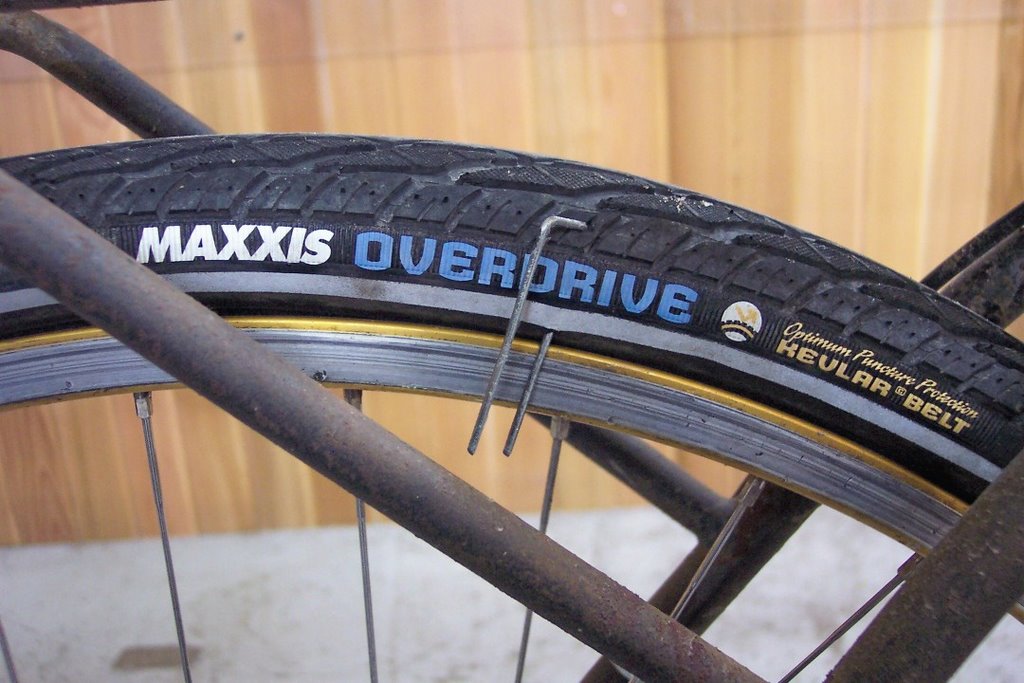
Friday, September 08, 2006
Tuesday, September 05, 2006
And the pounds just melt away...
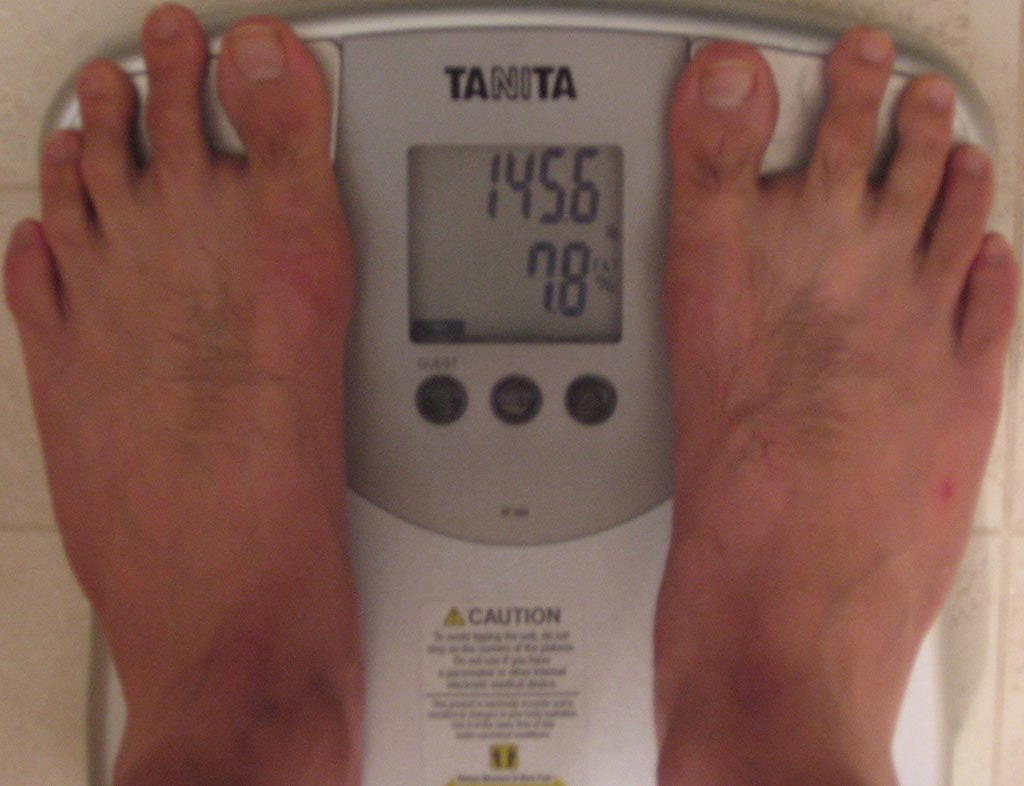
145.6 lbs (66.2 kg).
7.8% body fat.
At 6 feet 2 inches (187 cm), the numbers may seem really skinny by normal standards, but, in the cycling world, it is actually the average for billy goats. I.e. climbers.
For the time being, 7.5% to 8% body fat is my comfortable level. At 7% body fat and below, I feel cold easily.
How important is weight?
What makes a great climber, especially in the mountains, is an excellent power to weight ratio.
Power to weight ratio has two components: first, the ability to ride for long periods of time at a Maximum Sustainable (MS) power.
Typically a top climber can ride at 10% or more above threshold power (or threshold heart rate) for 30-60 minutes.
Second, top climbers have a low enough body weight so that the MS power translates into an advantage going uphill. Having a high maximum sustainable power output will make an excellent time-trialist on flat roads where the main obstacle is wind drag.
To carry over this advantage to climbing, you need a low enough body weight in relation to your MS power. This is especially true on long and steep climbs.
On short climbs of less than 5 minutes, so-called "non-climbers" can still make it over with the front riders with their very high MS power even though they may have an inferior power-to-weight ratio, due to their heavier body weight.
Bjarne Riis, winner of the 1996 Tour de France, illustrated how much body weight can make a difference while going uphill. Riis beat the great Miguel Indurain in 1996. At the time of his win Riis weighed 150lbs (68kgs) and had a MS power of 480 watts while going all-out on a climb or time trial. This gave him an incredible power to weight ratio of 7 watts per kilogram (480 / 68 = 7). 7 watts /kg is widely regarded as the magic number in order to be one of the world's best.
Indurain had a MS power of 550 watts when going all-out, a much higher number than Riis. However, he weighed in at 176lbs (80kgs), 26lbs heavier than Riis! This gave him a power to weight ration of 6.8 watts/kg (550 / 80 = 6.8), 0.2 less than Riis.
Indurain's much higher MS power gave him the advantage in the time trials, where the main obstacle is wind drag. However, on the longest, steepest climbs of the Tour, this was not the case, as Riis' 0.2 watts/kg advantage made all the difference.
[ . . . ]
Some cyclists are already at 4% - 5% body fat (for men), and in this case the only improvements they can make to their climbing is by increasing their threshold and MS power. (Source).
Here's a mathematical example:
Utilization of a rider’s Power-to-Weight Ratio (P/W) is most commonly found when assessing their climbing ability. Let us assume there are two riders of equivalent abilities with identical bikes and components. Both cyclists will be climbing the same climb side-by-side at exactly the same time on exactly the same day under exactly the same conditions.
Rider-1 weighs in at 175 lbs. and has an average sustainable power on said climb of 475 watts. Rider-2 weighs in at 130 lbs. and has an average sustainable power on the same climb of 380 watts. If someone were to base their opinion of each rider’s climbing ability solely on their power, they might think that Rider-1 would be able to easily beat Rider-2 to the top of the mountain. Granted, Rider-1’s sustainable climbing power is 95 watts GREATER THAN Rider-2’s (ca. 20%); however, power is not the only variable riders are aware of while dragging themselves up a climb. TOTAL Weight (body, bike frame, components, wheels, etc.) also plays an important role.

The effort a climbing rider (measured in power) is directed in part along each of these two vectors. Although the rider’s mass factors into each of these directional vectors, it plays a bigger role as WEIGHT when you factor in the affect of gravity along the vertical vector. Stated simply, P/W could also represent H/V as a means of determining how much of a rider’s climbing power will be used to move along the horizontal vector (general direction of progression) compared to overcoming the influences of gravity along the vertical vector.
Getting back to our two riders. When we now account for each of their weights in addition to their climbing powers, we find that P/W1 = 2.71 Watts/lb, whereas P/W2 = 2.92 Watts/lb. All things being equal, Rider-2 will get to the top of the climb before Rider-1, even though Rider-1 can generate approximately 20% more power than Rider-2. (Source)
Power-to-Weight Ratio (besides talent and physical fitness, of course) could explain for Discovery Channel Pro Cycling Team 2006's latest sign up: Janez Brajkovic.

Janez is 5 feet 8 inches (172 cm) tall, weighs between 115 to 130 lbs (52 to 59 kg), and climbs like a bat out of hell.

Since his first racing season in 2001, Brajkovic has exhibited his skill at the top U23 level and had a breakthrough season in 2004, capped by his victory at the Worlds in Italy. On paper, Holland´s Thomas Dekker appeared unbeatable, but Brajkovic won the near 37km event by 18 seconds over Dekker at an average speed of 47.0km/h (29.2mph), and was the only man to break the 47 minute mark too.
Yes, cyclists who specialize in climbing look scrawny, but try keeping up with them in the mountains.
Any hulk, wrestler, or macho man who thinks otherwise is welcome to prove me wrong by joining me for a Mount Hamilton Double with 9536 ft / 2907 m of climbing (road), or a Mount Diablo Double with 9044 ft / 2757 m of climbing (off-road). Let's see how your giant pecs and 400 lb (181 kg) bench presses help you keep up in the mountains :P
Saturday, September 02, 2006
Monday, August 28, 2006
Specifications changed without notice

For the x60 generation of cassettes, Shimano cut the notches for the final gear shallower and terminate the cut at a right angle instead of beveling them. This can be observed in the picture above. Note that the notches are cut deeper, and the terminations are beveled, in the x50 series gear on the right.
The change do not affect users of Shimano rear hubs. However, other hub (DT, Chris King, Ringlè) users quickly discover that their cassettes remain loose no matter how much they torque down the lock ring.
The remedies are:
1.) Purchase either a 0.5mm spacer from Chris King or a 0.3mm (preferable) spacer from Wheels Manufacturing, Inc. The spacer will go on first, and then the cassette is installed. You will know if the spacer is too thick: the chain will rub on the seat stays in the smallest gear no matter how much you adjust your derailleur.
2.) Fabricate a spacer with tin snips from a soft drink can.
3.) Substitute the gear with one from the previous generation. I.e. a x50 series cassette.
4.) Very carefully file down the splines on the freehub. If you have nerves of steel, you may use a dremel. Of course, it goes without saying that this option is only viable if the freehub body is made of aluminum.
It is worth nothing that some riders who chose option 1) or 2) obtained a Chris King cassette lock ring. The Chris King lock ring has more threads of engagement than Shimano's. Sometimes the spacer can reduce the threads of engagement so much that the lock ring will strip before the specified torque (40 Nm) is achieved.
I used a combination of 3) and 4) for my Ringlé rear hub.
Sunday, August 20, 2006
Bare
I am seriously contemplating removing the hair on my legs. As I am neither partial towards shaving (it would leave stubble, which would catch on my tights), nor waxing (hot dripping wax. Umm... S&M not in to I am.), I am probably going the route of depilatories.
Why shave / wax the legs?
1.) Cycling tights, knee and leg warmers are easier to don and doff.
2.) Less mud and horse crap cling to your legs when mountain biking.
3.) When you crash while road biking, the road rash is less severe as there are no hairs to catch on the asphalt and rip patches of skin off.
4.) Wounds are easier to clean, keep clean, and heal faster (no hairs in the way).
5.) Removal of bandages is less painful as there are no hairs to yank off.
6.) For long rides, the hairs on your legs increase aerodynamic drag (though it is miniscule).
7.) Bare legs feel cooler during warm weather as there is no hair to impede passing airflow.
8.) With no hairs to get yanked or pulled, it is easier to massage the legs after hard rides.
9.) Without hair, sunblock, insect repellent, deep heat pain-relieving creams go a long way.
Homophobes and men insecure about their sexual identities / preferences should hold their tongues with regard to this post. If hair follicles are the defining mark of masculinity, then Sasquatch and Chewbacca the Wookie must be history's epitomes of the alpha male.
Interesting poll here.
Update:
Picked this up tonight.
Saturday, August 19, 2006
Fog & Night
Went for a night ride at the Marin Headlands.

Barry Baker Tunnel.

View from the top of Hawk Hill (920 ft): the Golden Gate Bridge partially lost in fog. (In the day.)
It was dark. Wind gusts occasionally knocked me sideways. My bar ends were slick from condensation. The whistling wind, lonely and grateful for company, played counterpoint to my ragged breathing as I climbed into the night.
Friday, August 18, 2006
Black Mountain Dawn Ride
Why there are perks to bouncing out of bed at 4 in the morning:
 Map.
Map. Looking back at final climb up to the summit.
Looking back at final climb up to the summit. Close up.
Close up.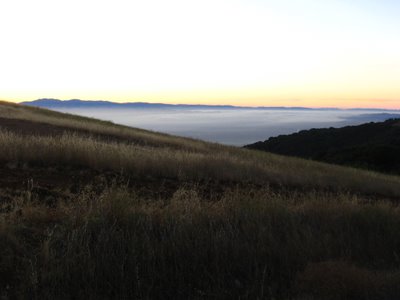 A peak at dawn while climbing up.
A peak at dawn while climbing up. Waiting (and listening to the whispering wind).
Waiting (and listening to the whispering wind). Sunrise at 2800 ft (853.7 m).
Sunrise at 2800 ft (853.7 m). The first rays of the sun hitting the summit rocks of Black Mountain.
The first rays of the sun hitting the summit rocks of Black Mountain.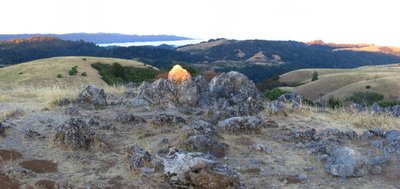 Close up.
Close up. Solitude at dawn.
Solitude at dawn. And the open trail...
And the open trail...Wednesday, August 16, 2006
Unbent
'Got round to replacing the handlebar bent from the Bolinas Ridge Trail Ride II crash:
 The casualty: X-Lite's 540 titanium handlebar, 3 degree sweep. No, it's not "Mad in England." The "e" rubbed off over the years :-P
The casualty: X-Lite's 540 titanium handlebar, 3 degree sweep. No, it's not "Mad in England." The "e" rubbed off over the years :-P Red circle denotes the bulge when the bar bent.
Red circle denotes the bulge when the bar bent. The replacement: a Litespeed titanium handlebar.
The replacement: a Litespeed titanium handlebar.The Litespeed handlebar is 2 inches (5.08 cm) wider than the X-lite bar. While I appreciate the added room in the cockpit (for more lights, gizmos, etc.), I wonder if it will increase the risk of hooking hanging vines, branches and bushes on tight singletrack.
Tuesday, August 08, 2006
Bolinas Ridge Trail Ride II
Bolinas Ridge Fire Road in summer. Refer to the first ride report for more comprehensive trail directions.
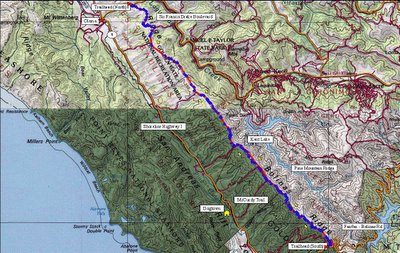 Map and route of Bolinas Ridge Trail. 250 track points laid by the GPS unit.
Map and route of Bolinas Ridge Trail. 250 track points laid by the GPS unit. TOPO!'s elevation profile.
TOPO!'s elevation profile. Trailhead by Sir Francis Drake Boulevard. Frankly, I prefer it when the grass is green in winter.
Trailhead by Sir Francis Drake Boulevard. Frankly, I prefer it when the grass is green in winter. The 1st climb.
The 1st climb. Looking back just before the 1st cattle gate. Mount Vision to the left. The body of water is Tomales Bay.
Looking back just before the 1st cattle gate. Mount Vision to the left. The body of water is Tomales Bay.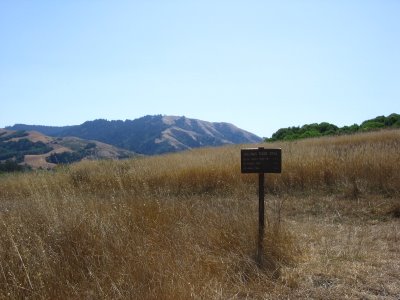 First posted sign: follow the main trail uphill to the right. I think the peak ahead is Mount Barnabe (1466 ft) in Samuel Taylor State Park.
First posted sign: follow the main trail uphill to the right. I think the peak ahead is Mount Barnabe (1466 ft) in Samuel Taylor State Park.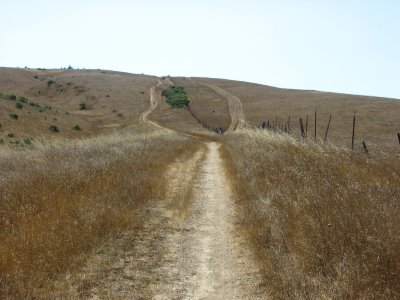 2nd climb.
2nd climb.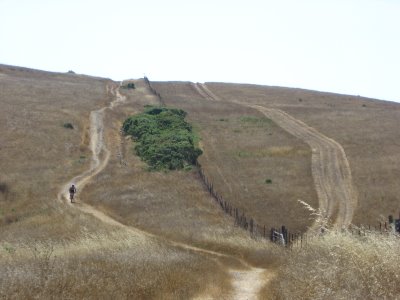 A rider on his way down.
A rider on his way down. 2nd cattle gate.
2nd cattle gate.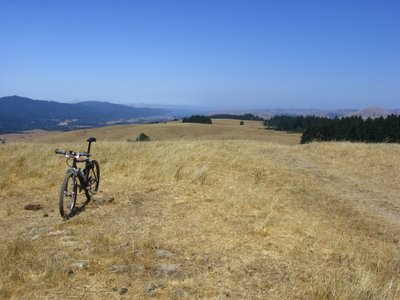 Elevation 1080 ft. Looking back.
Elevation 1080 ft. Looking back. Wider view.
Wider view. Just before entering the forest. Met another biker here, Jeff. We rode together until the end of the trail from here.
Just before entering the forest. Met another biker here, Jeff. We rode together until the end of the trail from here. Amid the redwoods. What it looks like when there's fog.
Amid the redwoods. What it looks like when there's fog.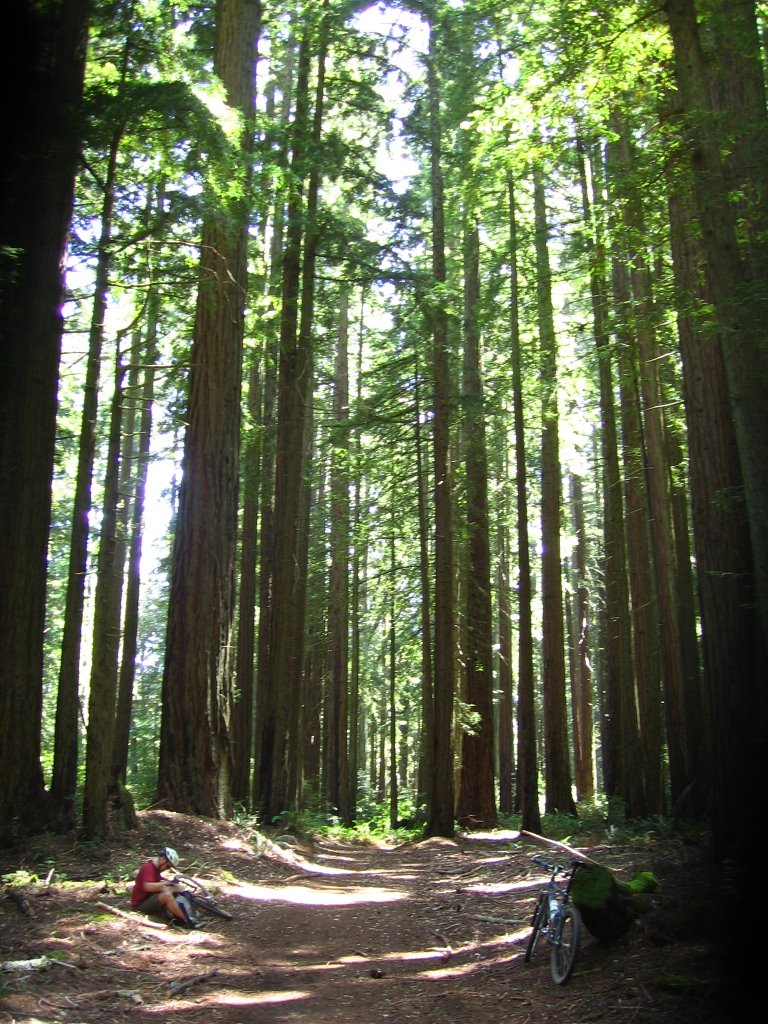 Taking a break.
Taking a break. Leaving the forest. Here's Jeff.
Leaving the forest. Here's Jeff. Moi.
Moi.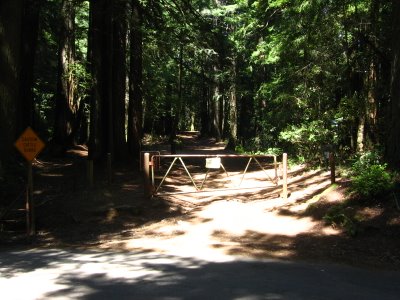 Elevation 1500 ft. Southern trailhead of Bolinas Fire Road. It intersects Bolinas - Fairfax Road at its highest point. The northern end of West Ridgecrest Boulevard also accesses this trailhead.
Elevation 1500 ft. Southern trailhead of Bolinas Fire Road. It intersects Bolinas - Fairfax Road at its highest point. The northern end of West Ridgecrest Boulevard also accesses this trailhead.Here, we parted ways: Jeff had a long way to ride back to his vehicle at Azalea Hill parking lot, while I am to double back the way I came.
 Elevation 1604 ft. Looking west at Bolinas, Bolinas Lagoon, and the Pacific Ocean.
Elevation 1604 ft. Looking west at Bolinas, Bolinas Lagoon, and the Pacific Ocean. Pine Mountain Ridge. In the canyon between the two ridges (I'm standing on Bolinas Ridge) lies Kent Lake.
Pine Mountain Ridge. In the canyon between the two ridges (I'm standing on Bolinas Ridge) lies Kent Lake. Closer view. What Bolinas Ridge looks like from Frisbee Knoll.
Closer view. What Bolinas Ridge looks like from Frisbee Knoll. Close up of Pine Mountain. A view of Bolinas Ridge from the top of Pine Mountain.
Close up of Pine Mountain. A view of Bolinas Ridge from the top of Pine Mountain. Back in the forest.
Back in the forest.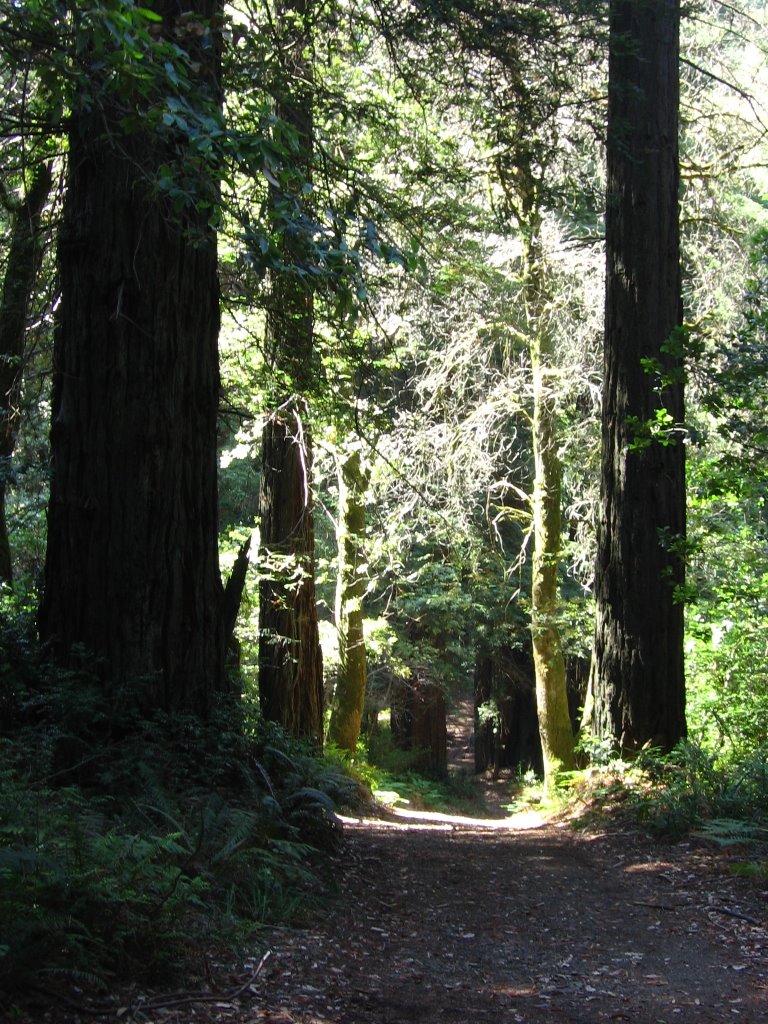 The climbs that tormented earlier now become fun descents, with roots serving as launching pads.
The climbs that tormented earlier now become fun descents, with roots serving as launching pads.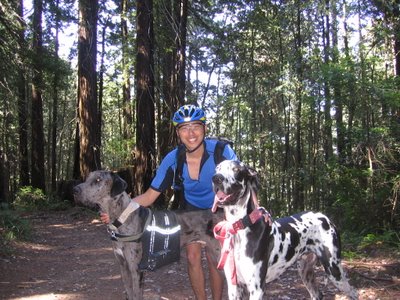 A trio of hikers were walking their Great Dane puppies in the forest. Both dogs are only 9.5 months old. They do not reach their full size until they reach 2 years of age. I just love dogs :-)
A trio of hikers were walking their Great Dane puppies in the forest. Both dogs are only 9.5 months old. They do not reach their full size until they reach 2 years of age. I just love dogs :-)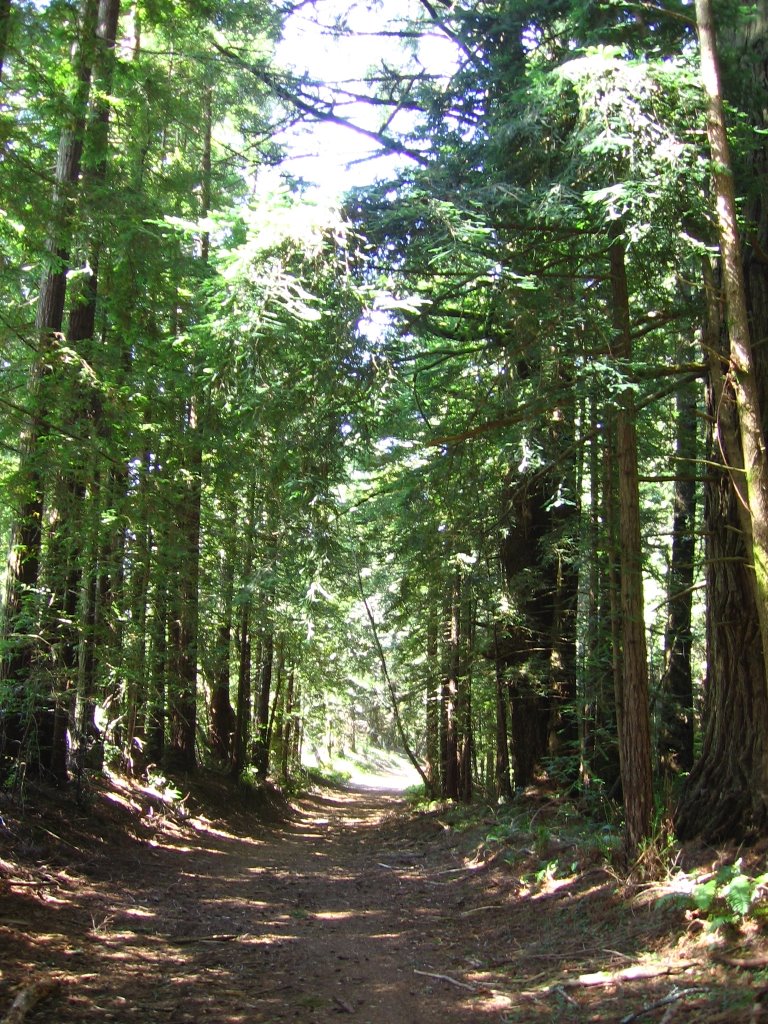 Leaving the forest.
Leaving the forest. Back on open grassland.
Back on open grassland.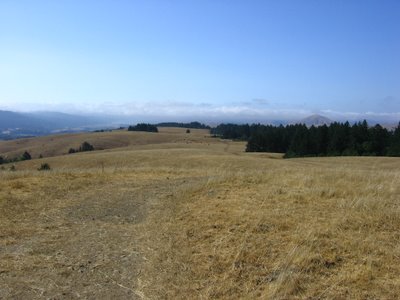 The cows have been let out to pasture.
The cows have been let out to pasture. Closer look.
Closer look. Continuing the descent. The peak to the right is Black Mountain (1280 ft).
Continuing the descent. The peak to the right is Black Mountain (1280 ft). A wider view.
A wider view. Final descent towards Sir Francis Drake Boulevard (left of the middle).
Final descent towards Sir Francis Drake Boulevard (left of the middle).Before this, I had a spectacular crash on the way down. I was pursuing another biker when my front wheel went into a hole. The guy in front of me, having 100mm of travel in front, and 80mm in the rear, barely made it. My vintage bike, with 63mm of travel in front, didn't have a prayer. The next thing I knew, I was vaulted over the front handlebars as my bike performed an endo. There wasn't even enough time to touch my brakes or unclip from my pedals. I only had time to instinctively retract my arms to my body.
It was strange. The first couple of thoughts I had after impact were:
1.) My medical insurance deductible is US$5000.
2.) I don't have helivac (helicopter evacuation) insurance. Check out francois' cool pictures of his helivac experience.
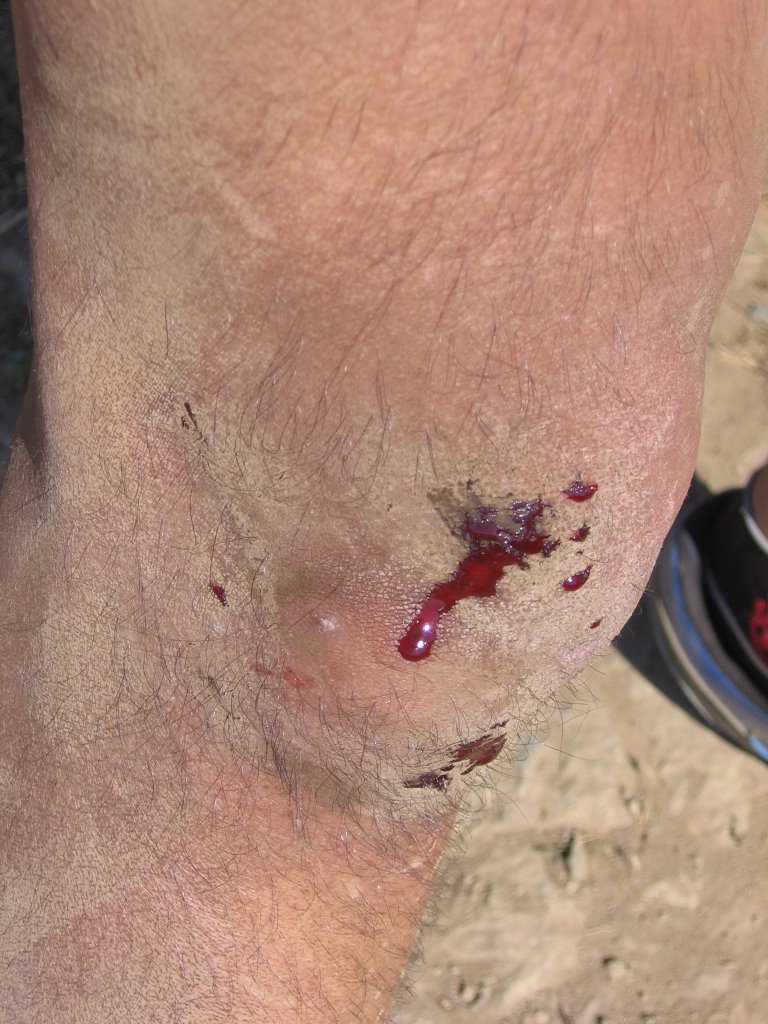 The outside of my right knee took the brunt of the impact. Check out the contusion where the blood is flowing down. It eventually grew to the size of a golf ball. This is yet another reason why you pack painkillers in your first aid kit, young padawan.
The outside of my right knee took the brunt of the impact. Check out the contusion where the blood is flowing down. It eventually grew to the size of a golf ball. This is yet another reason why you pack painkillers in your first aid kit, young padawan.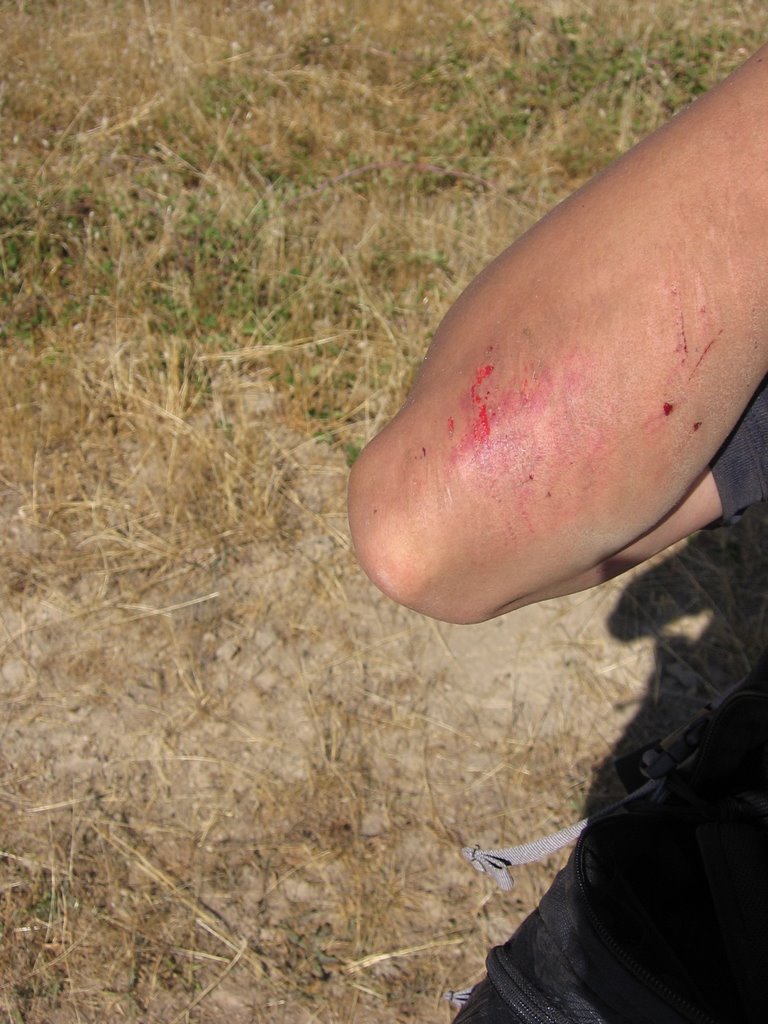 Right elbow.
Right elbow. Small scruff on my left arm. I still have no idea how I could have scrapped this side on my body as all my other injuries are on my right side. I do not remember tumbling.
Small scruff on my left arm. I still have no idea how I could have scrapped this side on my body as all my other injuries are on my right side. I do not remember tumbling. Under my jersey, bruised ribs. Under my cycling shorts, bruised hip. Still, I think I got off lightly for hitting the ground at 28.1 mph (45 km/h).
Under my jersey, bruised ribs. Under my cycling shorts, bruised hip. Still, I think I got off lightly for hitting the ground at 28.1 mph (45 km/h).Note to self: when riding a hardtail, do not chase a guy on a full-suspension bike down the mountain :-P
Epilogue:
Total distance: cyclo-computer 22.5 miles (36 km) / GPS 22.45 miles (35.92 km) / TOPO! 22.50 miles (36 km).
Total elevation climbed: Altimeter 3300 ft (1006 m) / GPS + TOPO! 3317 ft (1011.28 m).
Temperature range: 68 F to 78 F (20 C to 25.6 C).
Fluids consumed: 56 fl. oz. of Gatorade, 20 fl. oz of water.
Subscribe to:
Posts (Atom)
